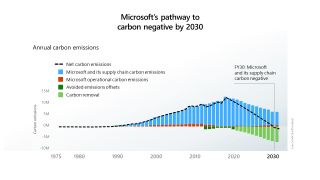The recyclable PS5 packaging is the first small step for a console generation that must reckon with gaming's carbon footprint
PlayStation's PS5 packaging reminds us that next-gen arrives at the beginning of Earth's most critical decade

Lots of people have been talking about the PS5 box. Too many people have been talking far too much about the PS5 box. Geoff Keighley decided to give it an erotically charged photoshoot in the middle of his street, for goodness sake. But out of all this box-talk, there's one thing I've noticed that curiously few are mentioning: the PS5 packaging is notably plastic-free.
That's not to say you won't find a single shred of silicon swaddled around your new console come launch day (cable ties and scratch protection cloth still remain part of the package), but PlayStation has ditched the styrofoam shock proofing that you'll find in the Xbox Series X's packaging, opting instead for a recycled cardboard alternative that we can confirm looks a bit like a giant egg box.
The same goes for the DualSense: whereas every new DualShock 4 controller is ensconced in a translucent polymer film designed to show it off on store shelves, its successor now comes in a much more easily recycled box. It might not seem like a particularly interesting observation compared to the PS5 itself, but it's the first tangible indication of a generation of hardware that's reckoning with its future, and the role its industry has to play in the fight against climate change.
Thinking outside the box

"This will be the first generation of hardware to witness an epoch-defining period in human history."
Last year, PlayStation confirmed it had joined the United Nations' Play for the Planet initiative, making a public commitment to reducing its carbon footprint across its operations, corporate messaging, and hardware development, with the PS5 apparently boasting significantly improved energy efficiency than that of the PS4.
On the other side of the competition, Microsoft has already celebrated the creation of 825,000 carbon neutral Xbox consoles, and I'm sure you've heard plenty about the company's wider plans to become carbon negative by 2030. These efforts are a welcome shift away from the industry's pollutant-heavy past, but they need to be the first small step in a marathon if these two gaming titans want to be on the right side of history when it comes to addressing the biggest crisis our planet has ever faced.
A Verge report last year estimated that PlayStation 4 units had generated around 9.8 million tons of carbon dioxide since 2013, or 22 million tons if you count their associated energy consumption. When placed alongside average annual global emissions, that number outranks a handful of small nations. Predictions for the Xbox One are worse, with Microsoft's current-generation console estimated to be responsible for emitting 35 million tons over the last seven years.

In total, US gaming platforms now represent 34 terawatt-hours a year in energy usage, equivalent to over five million cars' worth of carbon emissions, and as the games market continues to grow, so too will those statistics.
Sign up to the 12DOVE Newsletter
Weekly digests, tales from the communities you love, and more
Add in the high energy demands of rising trends such as cloud gaming and digital downloads, alongside the continued extraction of conflict minerals to manufacture the consoles' chips and circuit boards (Nintendo has the worst track record out the 'big three' in this area), and the picture of the gaming's imprint on the environment suddenly becomes pretty poor.
Recyclable packaging and low power modes ain't gonna cut it, basically, with the industry's contributions to global emissions worsening despite continuing top-down and bottom-up efforts such as these. But with great power consumption, comes great opportunity.
The major players in the games industry now command a uniquely wide and diverse audience that is predicted to soon eclipse those across all other forms of consumer entertainment. Put simply, if the first strategy in the fight against climate change is raising awareness, then games are already at the frontlines of the battlefield.
Generational shifts


We have already seen a number of titles address global warming, and our culpability in it, by utilising their interactivity, but there's so much more that can be done. Sony has said its exploring ways to use PS VR as a platform for education on issues around global warming and sustainability, for example - check out this UNEP programme made in Dreams.
Microsoft, meanwhile, has partnered with organisations like the WWF to promote its "Build a Better World" programme in Minecraft, which has become particularly helpful this year as an online educational tool for remote learning environments around the world. Again, while laudable, these initiatives are best viewed as a starting point for what's possible through the medium, rather than an assurance that the industry is doing all it can.
The next-generation of gaming will no doubt give us hundreds of incredible games to play, but it will also be the first generation of hardware to witness an epoch-defining period in human history.

The successors to the PS5 and Xbox Series X will be launching on a planet that will look radically different to the one we have now, then, but these incoming next-gen consoles have a role to play in making sure that difference is a positive one.
Humans are the authors of climate change, and the only ones capable of authoring its reversal. The pen that the games industry holds in that collective authorship is sizeable, and while Microsoft and Sony's climate-conscious efforts ahead of next-gen are far from satisfactory, it does suggest that both companies are finally on the right track towards building an industry that heals the planet, rather than continues to hurt it.
For more, check out the best Call of Duty games in the series' history, or check out our official PS5 unboxing in the video below.
I'm GamesRadar's Features Writer, which makes me responsible for gracing the internet with as many of my words as possible, including reviews, previews, interviews, and more. Lucky internet!












